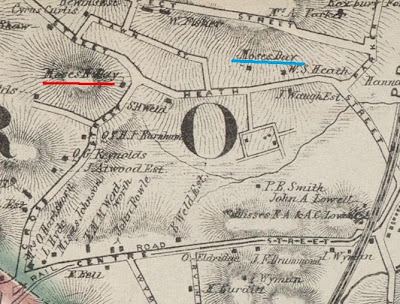
Creighton street development plan - 1859.

Bromley Atlas, 1884.

Creighton st. 1895 (
David Rumsey Collection).
As a follow-up to an
earlier street name post, I've done some digging and added Hyde Square's Creighton street to the list of known street name origins. As so often happens in local history, I came about the source of Creighton street's name in a roundabout way. I was investigating the Blessed Sacrament Church property, which once was the site of the Withington Tavern. Phineas Withington sold the tavern and 3 acres of land to Phillip Wentworth for $6000 in 1805. The second map above, dated 1884, shows Elizabeth Wentworth still in posession of the property. It was Elizabeth who led me to the Creightons.
Addendum (9/29/09) In browsing the History of the First Church in Roxbury, I learned that after Phineas Withington sold his inn to Phillip Wentworth, he opened another inn on Naushon Island during the War of 1812. The property plan at the top of the entry shows the Halsey Homestead Sites in 1859, with Creighton street in place - if only in the imagination of a surveyor. Notice the difference between the property plan and the 1884 map. On the 1859 plan, there were house lots laid out on either side of Creighton street. Twenty-five years later, Elizabeth Wentworth owned all the land on the east side of Creighton street. In fact, a deed search shows that Elizabeth purchased lots 22-27 in December of 1859, the same year the plan was drawn.
But what of the Creighton name? Elizabeth purchased the six house lots from Thomas Lloyd Halsey Creighton. In one bold stroke, we connect the Halsey name to Creighton - it's not often that it's that clear cut. Thomas Creighton was a Halsey, and his antecedent, Thomas Halsey, had owned the same land when Withington sold his tavern to Phillip Wentworth in 1805.
Unfortunately, Thomas Halsey's presence in Roxbury at the turn of the 19th Century has so far eluded my grasp. Thomas Lloyd Halsey was born in either Boston or Newburyport Massachusetts (depending on sources) in 1750, and died at Providence, Rhode Island in 1838, at 88 years old. Thomas had seven children, including another Thomas, who served as Consul to Buenos Aires during the early 1800s, and Harriet, who married Commodore John Orde Creighton, USN. They had six children, including Admiral Johnston Blakeley Creighton and Thomas Lloyd Halsey Creighton, whom we've already met. Various deeds list all six Creighton siblings as owner of the old Halsey estate.
That leaves me with two mysteries: how did the Halsey's get from Roxbury to Providence, where Harriet, mother of Thomas Lloyd Halsey Creighton, was born and died? And how did the children of Harriet - rather than Harriet's siblings - end up owning the property?
Unfortunately, I've been unable to nail down Thomas Halsey himself. A Thomas Halsey arrived at the Massachusetts Bay Colony in the early 1630s, but he moved on to New York, settling on Long Island. Online sources all point to that earlier Thomas Halsey, and leave us wondering where our Thomas came from, and how his family ended up in Providence.
As a bonus to our Creighton exploration, I can tell you that Commodore Creighton served in the Mediterranean, where his notorious temper involved him in multiple cases of abuse of seamen and near-mutinies. If Creighton street was named for the man, and not for the family, then it carries an interesting origin indeed. Beatings, whippings, petitions to Congress and charges brought against the man bring us back to a time when naval service - and sea-going life in general - was closer to slavery than our modern ideas of military service. An online search for John Orde Creighton will tell the tale for those interested.
You never know where you'll end up when you start digging into the most prosaic of local history topics.
Sources:
Thomas Lloyd Halsey genealogyThomas Lloyd Halsey papersHistory of the First Church in RoxburyNorfolk County Registry of Deeds:
23:85 - 6/11/1805: Phineas Withington to Phillip Wentworth.
283:82 - 12/30/1859: T.L.H. Creighton to Elizabeth Wentworth.
 Abt Hall - Jamaica Plain Neighborhood House.
Abt Hall - Jamaica Plain Neighborhood House.





